Coronation invitations through the ages
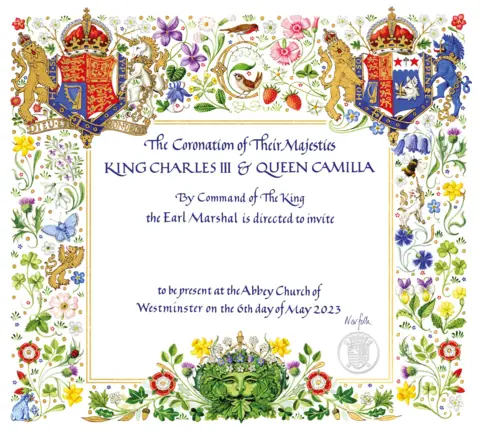 BBC
BBCThe first images of King Charles and Queen Camilla's coronation invitations have been released.
The ornate invites, printed on recycled paper, have been sent to 2,000 guests ahead of the 6 May celebration.
The invites form part of longstanding tradition, with the oldest coronation notes on file dating back to King George III's coronation in 1761.
In tribute to the upcoming coronation, the Royal Archives has unearthed invites across the monarchy's history.
They capture not only the evolving tastes of the royal family, but a snapshot of that time in history.
King George III - 1761
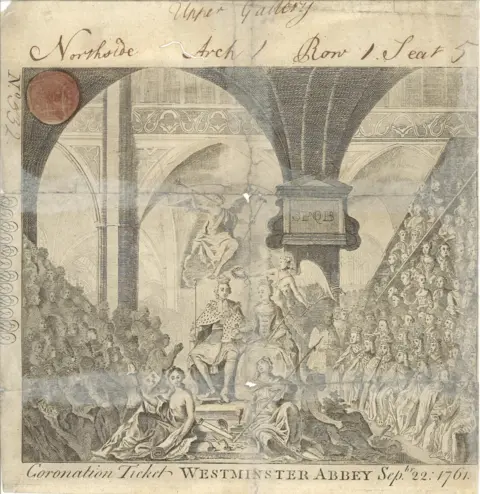 The Royal Archives
The Royal ArchivesThe oldest document reproduced by the Palace on Wednesday is from the coronation of King George III and Queen Charlotte on 22 September 1761.
It depicts the pair sitting alongside each other in Westminster Abbey, as winged angels flit above them and an expectant crowd watches on.
The image of the smiling couple intimately holding the orb and cross together suggests a well-worn intimacy - but in fact, George III had met his bride just a fortnight earlier.
The young king had ascended to the throne almost a year earlier upon the death of his grandfather George II, and was at that time a bachelor. He was 22 years old.
Charlotte of Mecklenburg-Strelitz, a minor princess from northern Germany, was identified as a suitable bride and a marriage contract was signed before they'd even met. She was just 17 years old.
She was brought to England to meet her new husband and they married a matter of hours after setting eyes on each for the first time.
Queen Victoria - 1838
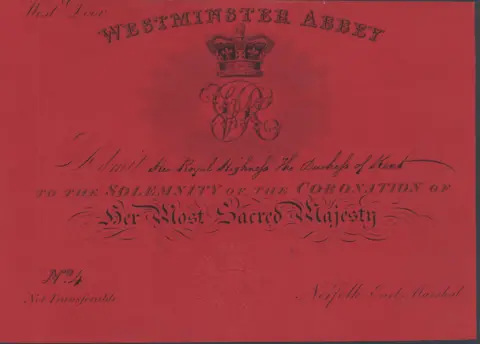 The Royal Archives
The Royal ArchivesThe second-longest serving monarch in British history, Queen Victoria, was crowned when she was just 18, and reigned for a total of 67 years.
Queen Victoria's bright red and green invites were the first to be printed in colour, as well as the first to feature a blind embossed seal from the Earl Marshal of England. To this date, the serving Earl Marshal - a hereditary royal officeholder - sends out and marks all coronation invites.
Queen Victoria's coronation was planned for 28 June 1838 and was much more of a grand and public occasion than the austere ceremony favoured by her uncle, King William IV.
The Queen drove from Buckingham Palace to Westminster Abbey in full state procession, in a Gold State Coach pulled by eight cream horses.
About 400,000 people lined the streets to see the coronation procession travel through London and the Queen.
The ceremony lasted a lengthy five hours, and as the Royal Archives notes, did not go completely according to plan.
The Queen recorded in her journal: "The Archbishop had (most awkwardly) put the ring on the wrong finger, the consequence being that I had the greatest difficulty in taking it off again, which I at last succeeded in doing, but not without great pain".
King George VI - 1937
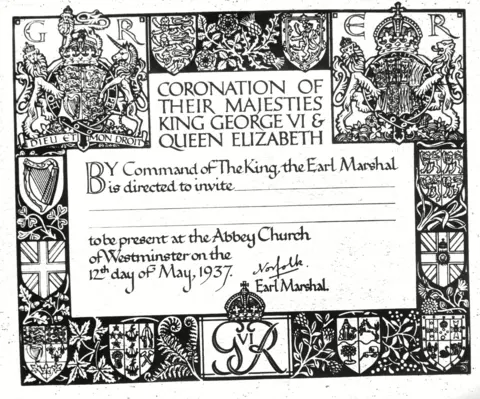 Everett/Shutterstock
Everett/ShutterstockHe was never expected to ascend to the throne, but King George VI rose to the challenge when his brother, Edward VIII, announced his shock abdication in December 1936.
Edward VIII had ascended to the throne earlier that year and, although resistant to the idea of a coronation ceremony at all, a date was set for 12 May 1937.
Preparations were well under way by the time he abdicated over his proposed marriage to Wallis Simpson, an American divorcee.
But it was his brother, George VI, who was anointed King in Westminster Abbey that day - three days shy of his 41st birthday.
The bold design of the invite, featuring a border of dominions, emblems and shields of arms, also paid tribute to the wider British Empire at the time, including India, Canada, New Zealand, South Africa and Australia.
Queen Elizabeth II - 1953
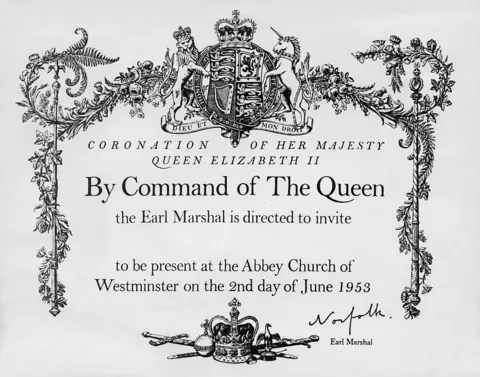 Hulton Archive
Hulton ArchiveA modern-minded monarch, Queen Elizabeth II's coronation made history as the first to be televised.
An estimated 27 million people watched the coronation live, over half the population of Britain, while a further 11 million people listened on the radio.
Wood engraver and book illustrator Joan Hassall designed the invite. Two decades later, she made history as the first woman to be elected a Master of the Art Workers' Guild. Ms Hassall became known to the Queen in 1948, when she won a competition to design a new £1 postage stamp.
For Queen Elizabeth II's Coronation in 1953, the young Prince Charles received his own specially illustrated invitation. The invitation, featuring colourful trumpeting and drumming soldiers, was also designed by Ms Hassall.
King Charles III - 2023
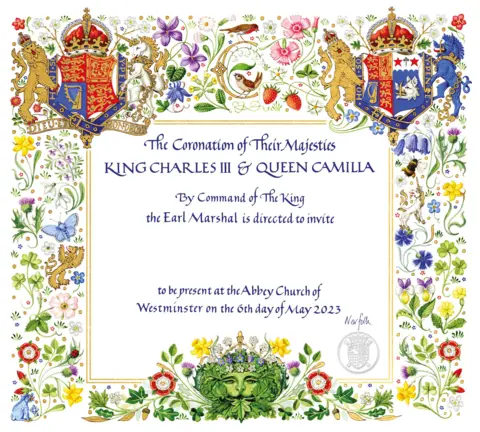
King Charles will be 74 when he is crowned on 6 May, but his invitation speaks to his progressive and green connection with the natural world.
His coronation invite was designed by Andrew Jamieson, a heraldic artist and manuscript illuminator whose work is inspired by the chivalric themes of Arthurian legend. Mr Jamieson is a Brother of the Art Workers' Guild, of which the King is an honorary member.
Reflecting the King's many years of environmental campaigning, the artwork for the coronation invitation uses the folklore figure of the "green man", with features made from ivy, hawthorn and oak leaves.
The original artwork for the invitation was hand-painted in watercolour and gouache.
In touch with the King's green credentials, the design will be reproduced and printed on recycled card, with gold foil detailing.
According to Buckingham Palace it is a symbol of spring and rebirth which celebrates a new reign.
The design also includes images of the natural world, including wildflowers, birds and insects native to the UK, as well as national and heraldic emblems.
